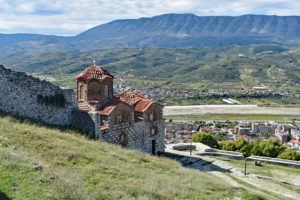The city of Berat, one of Albania’s oldest, can be ‘done’ as a day trip from Tirana, but we stayed for two nights at the “Rezidenca Dezaret”:https://www.silvertraveladvisor.com/review/accommodation/201573.
The ‘must see’ sight is the imposing castle high on a hill overlooking the town and Osumi River at 214 above sea level. Whilst you can walk up, it’s a steep climb and we were pleased of a lift from our driver.
Having paid our entrance fee of 100 Lek/75p, we walked through two arches: one facing north and the other east as this provided more secure defences against invaders.
At the first arch, was a red brick cross embedded into the wall, and on each point were four letters which appeared to be M K X X. We were told that if you take out the vowels from the street name, it gives the letters from the cross, although as the street was named, Rruga Mihal Komneini, something may have been lost in translation.
Like “Kruja Castle”:https://www.silvertraveladvisor.com/review/attraction/200217-review-kruja-castle, which we’d visited earlier in our trip, Berat is inhabited by around 350 people. There are also numerous restaurants, bars and shops with many traders displaying textiles including rugs, tablecloths and garments on the walls.
The castle is also a noted venue for wedding photography, and we encountered several couples spending the day on a photo shoot in all the prime locations. One bride wore trainers under her ‘meringue’ to cope with the cobbles and steep paths, whilst another couple employed a drone to fly overhead. When we reached the Panorama Viewpoint, where a third couple were, we felt you couldn’t intrude on them, although they did on us.
The impressive castle walls had large 4th century stones at the bottom but had been added to over the years.
There used to be a significant number of churches, our guide said 20, although Bradt quoted 42, but most are closed to preserve the frescoes and were locked during the atheist period. St Theodore’s Church had recycled pillars in the window and the small church of St Michael, with its restored roof, was nestled on the hillside and outside the castle walls. We were told it had been whitewashed inside and used to store phosphorous during the communist era.
As well as churches, our tour took us around two ruined mosques built by the Ottomans in the 15th century. The White Mosque got its name from its beautiful white stone, whilst the Red Mosque was damaged by bombs during World War 2, however the minaret has been restored.
This is a huge site, but we managed to make it to the Acropolis, the highest point.
After a couple of hours, of tramping and also time in the splendid Onufri Museum, we finally made our way back down on foot.










